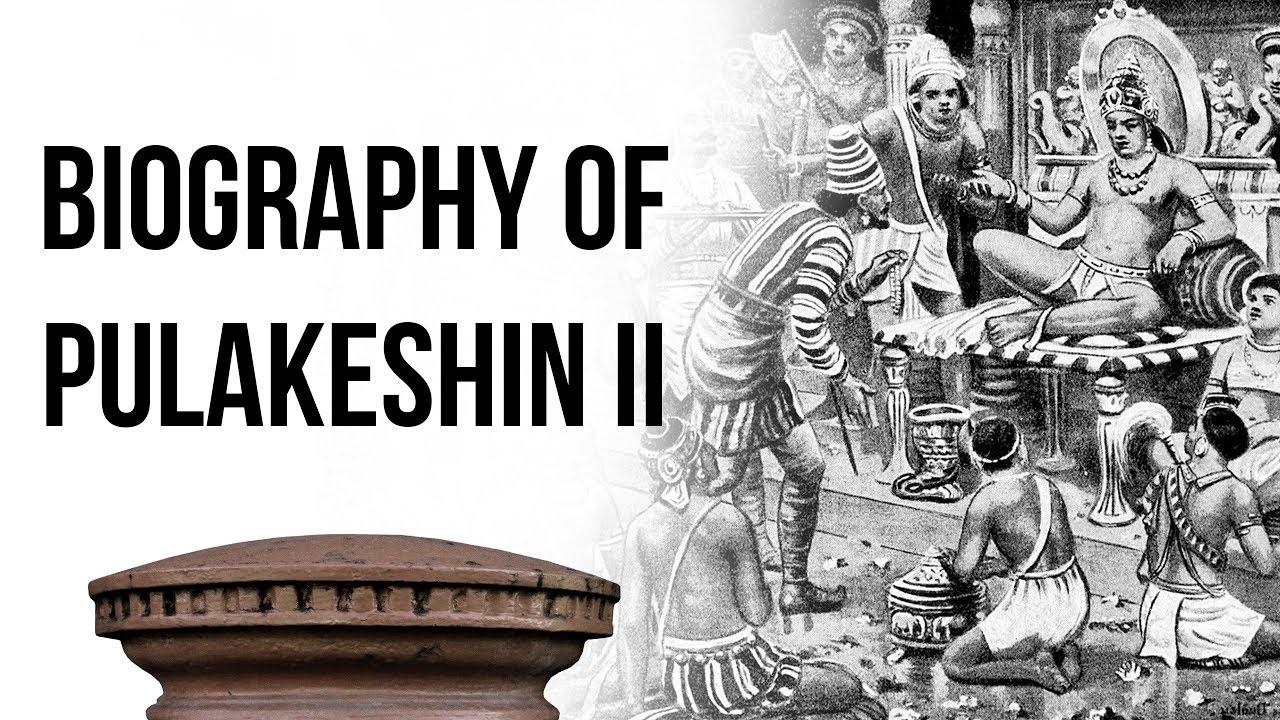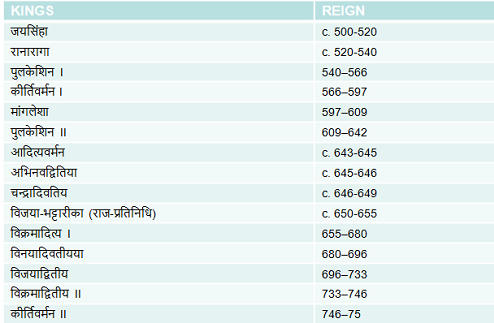Table of Contents
AIHOLE INSCRIPTION
- Many inscriptions found at Aihole, but the inscription which found at Meguti Temple popularly known as Aihole inscription, which has the significance in the history of India, witnessed for the many historical events of Chalukyas.
- There is a mention about the defeat of Harshavardhana by Pulikeshi II. And there is a mention about the victory of Chalukyas on Pallavas, also mentioned about the shifting of the capital from Aihole to Badami by Pulikeshi.
CHALUKYAS
- At a time when Harshavardhan was trying to unite the North, in the Southern half of India, too, a similar attempt was being made by another royal dynasty.
- In 6th Century A.D., there rose to power in the Deccan a dynasty famous as the Chalukya Dynasty. Opinions differ about the origin of this Dynasty.
- The name of this King was Pulakesin I. He is regarded as the real founder of the Chalukya Dynasty because of his well-established kingdom over a large portion of the Deccan.
PULKESIN 2
- Pulakesin II began his rule in the year 610 A.D. and assumed the pompous title of ‘Parameswara-SriPrithivi-Ballava-Satya- shraya.
- After attending to his primary duties in respect of peace and stability, he next entered upon a career of conquests and invasions. The chief aim of Pulakesin II was to convert the Chalukya Kingdom into a big southern empire.
EARLY LIFE
- His birth name was Ereya and he was born to Kirtivarman-I. Since, he was too young when his father died, his paternal uncle Mangaldesa was made the king.
- Some sources say that his uncle denied him his right to get the throne when he grown up and he rebelled against his uncle.
- Ereya organized an army near modern Kolar in Karnataka and defeated and killed Mangaldesa (Peddavadagur inscription).
CONQUESTS
-
- After Mangalesha’s death, Pulakeshin appears to have faced opposition from multiple rivals, including those who were loyal to Mangalesha and those who wanted to take advantage of the turmoil resulting from the Chalukya war of succession.
- The Aihole inscription declares that “the whole world was enveloped in the darkness that was the enemies”. Pulakeshin subjugated these enemies, and established the Chalukyas as the dominant power in the Indian peninsula
CONQUESTS
- Appayika and Govinda. The Aihole inscription suggests that two rulers named Appayika and Govinda rebelled against Pulakeshin but got defeated.
- Recapture of Banavasi. Pulakeshin’s predecessors had subjugated the Kadambas of Banavasi, but the Kadambas no longer recognized the Chalukya suzerainty during his reign. Pulakeshin marched against them, and besieged their capital of Banavasi.
- Alupas. According to the Aihole inscription, Pulakeshin subjugated the Alupas, who had earlier served as Kadamba vassals.
CONQUESTS
- Gangas of Talakad. The Aihole inscription credits Pulakeshin with subjugating the Gangas of Talakad, who had matrimonial ties with the Kadambas. After Pulakeshin’s victory over the Kadambas, the Gangas again accepted the Chalukya suzerainty, possibly without any military conflict.
- Mauryas of Konkana. After consolodating his power in southern Deccan, Pulakeshin successfully besieged the Mauryan capital Puri, which is variously identified as Gharapuri (Elephanta) or Rajapuri (near Janjira
HARSHAVARDHAN
- The date of Pulakeshi’s great triumph over Harsha in a battle fought primarily with elephants, on the banks of the Narmada at 618 AD.
- Pulakeshin, who ruled from the Chalukyan capital of Badami, challenged Harsha’s conquests. The former had established himself as ‘lord paramount’ of the south, as Harsha had of the north.
- Unwilling to tolerate the existence of a powerful rival in the south, Harsha had marched from Kanauj with a huge force. HARSHAVARDHAN
- In that great battle, Pulakesin II successfully resisted the army of Harsha and did not permit the invaders to advance towards the south but Hrashavardhan was defeated. • It is believed that the river Narmada was recognised as the frontier line between the empires of the ‘Lord of the North’ Harsha, and the ‘Lord of the South’ Pulakesin II.
- The celebrated Chinese Pilgrim Hiuen Tsang who visited India during the reign of Harshavardhan and became intimate to that Emperor, also visited the Chalukya territory in the South when Pulakesin II ruled.
PALLAVAS
- The Pallavas were the southern neighbours of the Chalukyas. The Vishnukundins were their allies at the time, and Pulakeshin’s subjugation of the Vishnukundins brought him in conflict with the Pallava king. The Chalukyas and the Pallavas fought several battles without conclusive results.
- Though he had fought against the Pallavas during the reign of King Mahendra Varman I, yet he invaded the same Pallava Kingdom once again when his earlier adversary’s son Narasimha Varman I ruled.
DEATH
- This time, however, Pulakesin’s expeditions did not succeed, and he had to return to his capital in shame. Soon thereafter, the Pallava King Narasimha Varman invaded the Chalukya Kingdom and his soldiers surrounded its capital, Badami.
- In that resistance battle, Pulakesin II lost his life in 642 A.D. Thus that ended the life of a great king who loved to fight battles.
WAR CONTINUED
- After the death of Pulakesin II, dark days descended on the Chalukya reign. His son and successor Vikramaditya I, after an initial period of political disaster, gradually became able to recover the lost glories of the Chalukyas.
- During his reign from 655 to 681 A.D., he conquered some territories of the Chola, Pandya and Kerala Kingdoms and merged those areas with the Chalukya Kingdom.
- But by 8th century A.D., the Deccan saw the rise of the Rashtrakutas to power. With that there ended the power of the Chalukyas in the South.
ADMINISTRATION
- Pulakeshin was a Vaishnavite, but was tolerant of other faiths, including Shaivism, Buddhism, and Jainism. He patronized several scholars, including Ravikirtti, who composed his Aihole inscription.
- The people of South India in general were religious. They followed the traditional Hindu ways of life in the society, with a liberal attitude.
- The Brahimns occupied a highly respectable position. They acted as ministers and advisers to the king as well as priests.
ADMINISTRATION
- He described the social life and manner of the people. People were simple, honest and faithful. They always regarded the morality and truthfulness in public life.
- They performed religious sacrifices such as the Asvamedha, the Vajapeya etc. The sacrificial form of worship was prevailing and the puranic deities rose into prominence.
- The sacrifical form of worship were sanctioned by Pulakesin I, Kirtivarman, Mangalesha and Pulakesin II. They performed vedic sacrifices themselves and honourd learned Brahmans.
ADMINISTRATION
- The Badami Chalukyas adopted a monarchical form of government.Sons of the king were trained with necessary skills in the art of warfare and peace.
- The king was assisted by a Mantrimandali and a set of high officials. The three important military officers: (i) Baladhikrita, (ii) Dandanayaka, and (iii) Mahaprachanda Dandanayaka.
ADMINISTRATION
- The Amatyas looked after revenue matters. The kingdom consisted of two parts: one ruled by the king directly and the other ruled by Samantas. The position of the Samantas also varied.
- The principal source of revenue for the state was land revenue. The rulers collected money through direct and indirect taxes resulting in high incidence of taxation on the common man. Land tax was collected in kind. ADMINISTRATION
- The empire was divided into Maharashtrakas (provinces), then into smaller Rashtrakas (Mandala), Vishaya (district), Bhoga (group of 10 villages) .
- Local assemblies and guilds looked after local issues. Groups of mahajanas(learned brahmins) looked after agraharas (called ghatika or “place of higher learning”).

























 WhatsApp
WhatsApp